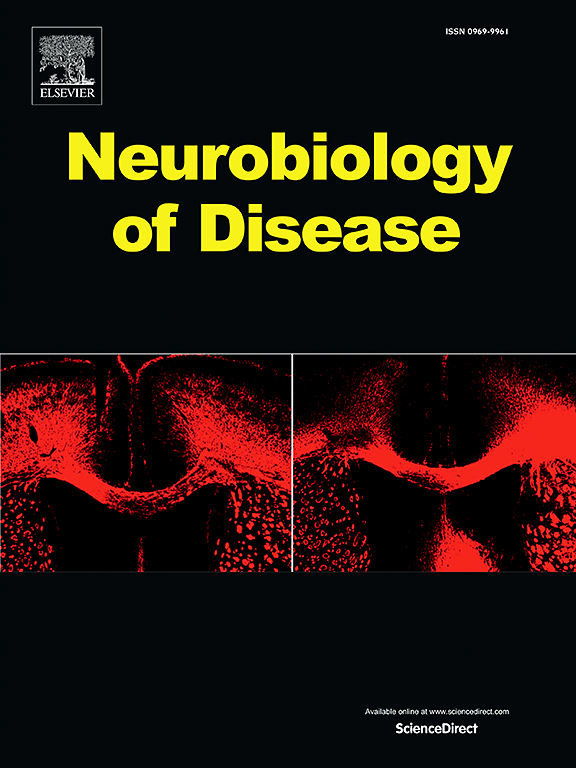无意识重塑丘脑底核的振荡地形:一项比较研究。
IF 5.1
2区 医学
Q1 NEUROSCIENCES
引用次数: 0
摘要
背景:许多中心在全身麻醉(GA)下进行深部脑刺激(DBS)手术,称为睡眠DBS。清醒状态帕金森病(PD)患者丘脑下核(STN)局部场电位(LFP)的记录为疾病机制和DBS优化策略提供了重要见解。相比之下,在ga诱导的无意识状态下记录的振荡的频谱特征仅部分被理解。目的:比较醒、睡两种状态下stn - lfp的频谱和地形特征,评估基于神经生理热点位置的DBS临床反应预测。方法:采用多触点DBS电极记录69例清醒PD患者(128个脑半球)和26例异丙酚麻醉PD患者(51个脑半球)术中stn - lfp。比较光谱功率(4 ~ 400 Hz)、地形热点分布及其临床预测值。评估lfp与额脑电图、麻醉深度和多巴胺戒断的关系。结果:睡着了联赛显示增加α(8 - 12 Hz),低β(13-20 Hz),和fast-gamma(110 - 140年 Hz)活动,并减少θ(4 - 7 Hz),高贝塔(21 - 30 Hz),和low-gamma(35 - 45 Hz)权力,而高γ(60 - 90 Hz), slow-HFO 赫兹(205 - 295)和fast-HFO(305 - 495年 Hz)活动保持不变而清醒的状态。在睡眠DBS下,频谱地形图向中、后、下移动,失去临床预测价值。stn - lfp反映异丙酚诱导的额叶脑电图变化,而多巴胺戒断时间对睡眠- lfp无影响。结论:无意识重塑了PD患者STN的频谱和空间地形,因此失去了对运动dbs反应的预测价值。光谱特征在空间中的动态变化可能为未来量身定制的睡眠DBS提供信息。本文章由计算机程序翻译,如有差异,请以英文原文为准。
Unconsciousness reshapes the oscillatory topography of the subthalamic nucleus: A comparative study
Background
Many centers perform Deep Brain Stimulation (DBS) surgery under general anesthesia (GA), known as asleep DBS. Local field potential (LFP) of the Subthalamic Nucleus (STN) recorded in awake Parkinson's disease (PD) patients revealed important insights into disease mechanism and DBS optimization-strategies. In contrast, the spectral characteristics of oscillations recorded in the GA-induced unconscious state remain only partially understood.
Objectives
To contrast the spectral and topographical characteristics of STN-LFPs recorded in both awake and asleep states and assess the clinical DBS response prediction based on neurophysiological hotspot positions.
Methods
STN-LFPs were recorded intraoperatively from 69 PD patients (128 hemispheres) awake and 26 patients (51 hemispheres) under propofol-anesthesia using multi-contact DBS electrodes. Spectral power (4 to 400 Hz), topographical hotspot distributions and their clinical predictive values were compared. The relationship between LFPs and frontal-EEG, anesthetic depth and dopamine withdrawal were also evaluated.
Results
Asleep LFPs showed increased alpha (8-12 Hz), low-beta (13-20 Hz), and fast-gamma (110-140 Hz) activity, and decreased theta (4-7 Hz), high-beta (21–30 Hz), and low-gamma (35-45 Hz) power, while high-gamma (60-90 Hz), slow-HFO (205-295 Hz) and fast-HFO (305-495 Hz) activity remained unchanged compared to the awake state. Under asleep DBS the spectral topographical map shifted medially, posteriorly and inferiorly, hereby losing its clinical predictive value. STN-LFPs echo propofol-induced changes in frontal-EEG, while time of dopamine withdrawal did not impact asleep-LFP.
Conclusions
Unconsciousness reshapes the spectral and spatial topography of the STN in PD patients, hereby losing its predictive values for motor DBS-response. Dynamical changes of spectral features in space may inform future sleep-tailored DBS.
求助全文
通过发布文献求助,成功后即可免费获取论文全文。
去求助
来源期刊

Neurobiology of Disease
医学-神经科学
CiteScore
11.20
自引率
3.30%
发文量
270
审稿时长
76 days
期刊介绍:
Neurobiology of Disease is a major international journal at the interface between basic and clinical neuroscience. The journal provides a forum for the publication of top quality research papers on: molecular and cellular definitions of disease mechanisms, the neural systems and underpinning behavioral disorders, the genetics of inherited neurological and psychiatric diseases, nervous system aging, and findings relevant to the development of new therapies.
 求助内容:
求助内容: 应助结果提醒方式:
应助结果提醒方式:


